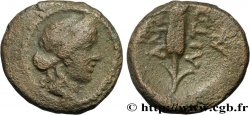v18_0060 - MACEDONIA - AMPHIPOLIS Tétradrachme stéphanophore
MONNAIES 18 (2003)
Starting price : 950.00 €
Estimate : 1 800.00 €
Realised price : 2 460.00 €
Number of bids : 9
Maximum bid : 2 915.00 €
Starting price : 950.00 €
Estimate : 1 800.00 €
Realised price : 2 460.00 €
Number of bids : 9
Maximum bid : 2 915.00 €
Type : Tétradrachme stéphanophore
Date: c. 148-147 AC.
Mint name / Town : Macédoine, Amphipolis
Metal : silver
Diameter : 29,5 mm
Orientation dies : 3 h.
Weight : 16,74 g.
Rarity : R2
Emission: 2e
Coments on the condition:
Exemplaire de qualité exceptionnelle pour ce type de monnayage avec une extraordinaire patine de médaillier à reflets gris bleutés, mordorés au revers. Revers de toute beauté, parfaitement centré
Catalogue references :
Predigree :
Cet exemplaire provient d’une vieille collection des années 30
Obverse
Obverse legend : ANÉPIGRAPHE.
Obverse description : Buste diadèmé et drapé d'Artémis Tauropolos à droite, l'arc et le carquois sur l'épaule, placé au centre d'un bouclier macédonien orné d'étoiles.
Reverse
Reverse legend : LEG/.
Reverse description : de chaque côté d'une massue ; au-dessus, main tenant un rameau d’olivier ; au-dessous, un monogramme ; le tout dans une couronne de chêne fermée par un foudre.
Reverse legend : MAKEDONWN
Commentary
Le seul autre exemplaire connu avec ce monogramme provient de la vente de la liste Ratto 6 (1922), n° 1305, de la vente Ratto du 4 avril 1927, n° 769, de la vente Baranowsky du 25 février 1931, n° 460 et de la liste Ratto 14 (1935), n° 1618. Il est de mêmes coins que notre tétradrachme, celui-ci étant en meilleur état. L’axe des coins pourrait être à 6 heures, la massue étant alors placée verticalement.








 Report a mistake
Report a mistake Print the page
Print the page Share my selection
Share my selection Ask a question
Ask a question Consign / sell
Consign / sell
 Full data
Full data









